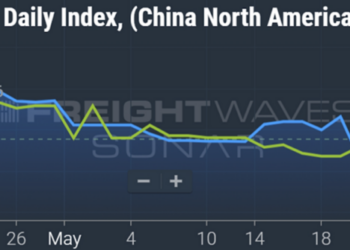An evergreen challenge for fleets is developing trust between not only drivers and fleets but between fleet operations and safety departments. The rise in technology and innovations in fleetwide telematics capabilities is creating new possibilities for fleets that historically have been reactive when it comes to developing safety programs.
Erin Baucum, director of client intelligence and analytics at Lytx®, spoke with FreightWaves about what fleets should consider when pairing safety with technology. For Baucum, the biggest challenge is first understanding the role safety plays in a fleet’s success.
To get the right data, she works with Lytx’s clients to create customizable data-reporting solutions and dashboards that blend telematics hardware inputs with information about driver behavior for a holistic view of the fleet’s safety.
For fleets struggling with higher insurance premiums, failing to keep up with these trends can mean the difference between success or bankruptcy in the form of nuclear verdicts or revocation of operating authority.
More safety data places more pressure on fleets
To highlight the growing safety risks for fleets, Lytx recently released a report leveraging 40 billion miles of driving data collected from its devices in 2023. Lytx’s “2024 State of the Data Report” showed more vehicles are creating more risk but that companies that implement a fleetwide safety program are seeing better results than those that are unprepared.
Brandon Nixon, chairman and CEO of Lytx, said in the report that “despite an overall rise in road risk, our data indicates that companies that have implemented fleet safety programs are seeing the results across a number of success metrics – from lower claims costs and more efficient fuel use to improved collision avoidance.”
One way fleets can address risk is understanding the riskiest times of the day to drive. Commute-hour risk is significantly different in the morning versus the afternoon. Despite similar congestion patterns, 4-7 p.m. commute hours are three times riskier than 5-8 a.m. commute times.
Risky driver behaviors is another area where clear trends appear. Among the 10 riskiest driving behaviors in the report, Lytx noted following too closely – by greater than 1 second but less than 2 seconds – remains the top challenge, followed by using a handheld device and not wearing a seat belt.
Larger cities mean more vehicles and higher risk for accidents. Among the five riskiest U.S. cities for driving, New York was No. 1, followed by Los Angeles, Chicago, Atlanta and Boston.
Using reports and data to coach and develop drivers
Baucum notes it’s important to take this voluminous data from many sources and build a story around it. Raw data needs to be analyzed, cleaned and then put into appropriate context if decision makers are to use it. Setting up reporting that describes or highlights the story is a first step.
Within the Lytx application, there’s a driver’s report that is accessible and lets users see which drivers are contributing the most risk. It’s powerful information and helps fleets guide coaching conversations and highlight specific risky behaviors.
Fleets can also use longer-term management-level reports. This data helps determine if there are trends or specific driver behaviors and can help fleets assess whether their coaching strategies are reducing unsafe behaviors.
Finally, the executive management reports and tools give fleets the ability to benchmark groups or business units against one another. For instance, a fleet may notice trends based on region, terminal, driver manager or division. The flexibility and customization of these reports have been used by some customers to prepare monthly safety meetings, where regional managers present and talk about their specific metrics and safety campaigns.
When looking at risky behaviors, the data does not follow a normal distribution but instead follows a power law dynamic. From Baucum’s experience working with clients using Lytx data, 20% of drivers were contributing 80% of a fleet’s risk.
The challenge for fleets is twofold: Identify, coach and develop that 20% of riskiest drivers while highlighting the positives and celebrating good driving behaviors. This can be tricky, as conversations with drivers on their driving behaviors can quickly get bogged down if fleets do not have the right data and fleet-reporting capabilities. On the flip side, fleets often overlook or fail to acknowledge the positive impacts of good driving behaviors.
Using custom reports for managers and executives is quickly becoming table stakes for fleets when they tackle these two challenges. An added benefit for identifying good behaviors is it allows fleets to learn from those drivers who are the safest, highlight their process and then share it within the organization to develop a positive safety culture.
Operations and safety go hand in hand
Having the reporting and data is the first step, but for fleets on the road, operations managers and safety specialists are often in separate roles. Large fleets can quickly get stuck in information silos where day-to-day business needs are not directly in sync with the goals of the safety department.
For Lytx, the quality of safety alerts is more important than the quantity, because drivers can quickly get frustrated by a barrage of notifications while driving. Modern tractors are equipped with various sensors in addition to the telematics and ELD devices. The result can be a nonstop symphony of lane, speed, distance and braking alerts all using unique tones or driver voice reminders.
The right alerts must be given at the right time if you want to build trust and a safety culture.
“Correcting behavior helps you not only avert risk but it also improves operations. But mostly it builds trust: You’re retaining drivers. They’re feeling more comfortable. Coaching isn’t used as a tool to defeat them but as a tool to help them get better,” said Baucum.
This trust must also exist between not only drivers and the company but between safety and operations departments. Fleet utilization goals hinge on getting the most value from drivers’ time, but unsafe drivers can quickly tank fleet utilization goals if they’re placed out of service or suspended for unsafe driving behaviors.
At the end of the day, Baucum believes those fleets that succeed are those that pair reporting with accountability to build trust. For Baucum and the Lytx clients she works with, fleet safety is more than a priority. It’s a responsibility.
To learn more, visit lytx.com.
The post Using telematics data and reporting to improve fleet safety and culture appeared first on FreightWaves.














